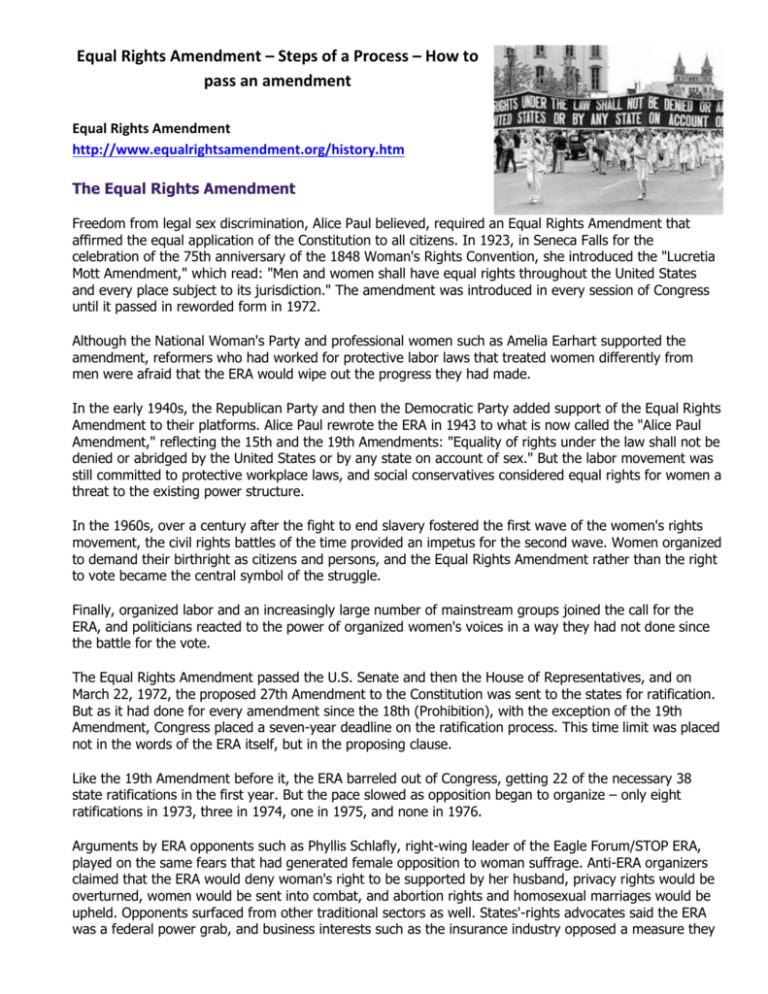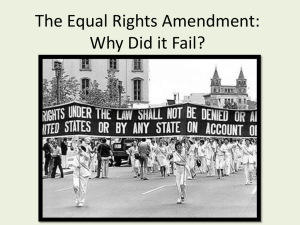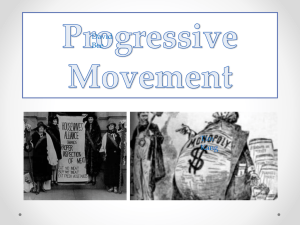57c. The Equal Rights Amendment
advertisement

Equal Rights Amendment – Steps of a Process – How to pass an amendment Equal Rights Amendment http://www.equalrightsamendment.org/history.htm The Equal Rights Amendment Freedom from legal sex discrimination, Alice Paul believed, required an Equal Rights Amendment that affirmed the equal application of the Constitution to all citizens. In 1923, in Seneca Falls for the celebration of the 75th anniversary of the 1848 Woman's Rights Convention, she introduced the "Lucretia Mott Amendment," which read: "Men and women shall have equal rights throughout the United States and every place subject to its jurisdiction." The amendment was introduced in every session of Congress until it passed in reworded form in 1972. Although the National Woman's Party and professional women such as Amelia Earhart supported the amendment, reformers who had worked for protective labor laws that treated women differently from men were afraid that the ERA would wipe out the progress they had made. In the early 1940s, the Republican Party and then the Democratic Party added support of the Equal Rights Amendment to their platforms. Alice Paul rewrote the ERA in 1943 to what is now called the "Alice Paul Amendment," reflecting the 15th and the 19th Amendments: "Equality of rights under the law shall not be denied or abridged by the United States or by any state on account of sex." But the labor movement was still committed to protective workplace laws, and social conservatives considered equal rights for women a threat to the existing power structure. In the 1960s, over a century after the fight to end slavery fostered the first wave of the women's rights movement, the civil rights battles of the time provided an impetus for the second wave. Women organized to demand their birthright as citizens and persons, and the Equal Rights Amendment rather than the right to vote became the central symbol of the struggle. Finally, organized labor and an increasingly large number of mainstream groups joined the call for the ERA, and politicians reacted to the power of organized women's voices in a way they had not done since the battle for the vote. The Equal Rights Amendment passed the U.S. Senate and then the House of Representatives, and on March 22, 1972, the proposed 27th Amendment to the Constitution was sent to the states for ratification. But as it had done for every amendment since the 18th (Prohibition), with the exception of the 19th Amendment, Congress placed a seven-year deadline on the ratification process. This time limit was placed not in the words of the ERA itself, but in the proposing clause. Like the 19th Amendment before it, the ERA barreled out of Congress, getting 22 of the necessary 38 state ratifications in the first year. But the pace slowed as opposition began to organize – only eight ratifications in 1973, three in 1974, one in 1975, and none in 1976. Arguments by ERA opponents such as Phyllis Schlafly, right-wing leader of the Eagle Forum/STOP ERA, played on the same fears that had generated female opposition to woman suffrage. Anti-ERA organizers claimed that the ERA would deny woman's right to be supported by her husband, privacy rights would be overturned, women would be sent into combat, and abortion rights and homosexual marriages would be upheld. Opponents surfaced from other traditional sectors as well. States'-rights advocates said the ERA was a federal power grab, and business interests such as the insurance industry opposed a measure they believed would cost them money. Opposition to the ERA was also organized by fundamentalist religious groups. worked for all her life. Pro-ERA advocacy was led by the National Organization for Women (NOW) and ERAmerica, a coalition of nearly 80 other mainstream organizations. However, in 1977, Indiana became the 35th and so far the last state to ratify the ERA. That year also marked the death of Alice Paul, who, like Elizabeth Cady Stanton and Susan B. Anthony before her, never saw the Constitution amended to include the equality of rights she had Hopes for victory continued to dim as other states postponed consideration or defeated ratification bills. Illinois changed its rules to require a three-fifths majority to ratify an amendment, thereby ensuring that their repeated simple majority votes in favor of the ERA did not count. Other states proposed or passed rescission bills, despite legal precedent that states do not have the power to retract a ratification. As the 1979 deadline approached, some pro-ERA groups, like the League of Women Voters, wanted to retain the eleventh-hour pressure as a political strategy. But many ERA advocates appealed to Congress for an indefinite extension of the time limit, and in July 1978, NOW coordinated a successful march of 100,000 supporters in Washington, DC. Bowing to public pressure, Congress granted an extension until June 30, 1982. The political tide continued to turn more conservative. In 1980 the Republican Party removed ERA support from its platform, and Ronald Reagan was elected president. Although pro-ERA activities increased with massive lobbying, petitioning, countdown rallies, walkathons, fundraisers, and even the radical suffragist tactics of hunger strikes, White House picketing, and civil disobedience, ERA did not succeed in getting three more state ratifications before the deadline. The country was still unwilling to guarantee women constitutional rights equal to those of men. The Equal Rights Amendment was reintroduced in Congress on July 14, 1982 and has been before every session of Congress since that time. In the 110th Congress (2007-2008), it was introduced as S.J.Res. 10 (lead sponsor: Sen. Edward Kennedy, MA) and H.J.Res. 40 (lead sponsor: Rep. Carolyn Maloney, NY). These bills imposed no deadline on the ERA ratification process. Success in putting the ERA into the Constitution via this process requires passage by a two-thirds in each house of Congress and ratification by 38 states. Equal Rights Amendment – Steps of a Process – How to pass an amendment U.S. History http://www.ushistory.org/us/57c.asp 57c. The Equal Rights Amendment As founder of the National Women's Party, Alice Paul first introduced the Equal Rights Amendment to Congress in 1923. Paul would work for the passage of the ERA until her death in 1977. "Equality of rights under the law shall not be abridged by the United States or by any State on account of sex." This simple sentence comprised Section 1 of the EQUAL RIGHTS AMENDMENT (ERA), which was first proposed in Congress by the National Women's Party in 1923. Feminists of the late 1960s and early 1970s saw ratification of the amendment as the only clear-cut way to eliminate all legal gender-based discrimination in the United States. Amending the Constitution is a two-step process. First, the Congress must propose the amendment by a twothirds majority in both the House and Senate. After proposal, it must be ratified by three-fourths of the state legislatures. Organizations like the National Organization of Women (NOW) began a hard push for the ERA in 1970. Phyllis Schlafly was perhaps the most visible opponent of the Equal Rights Amendment. Her "Stop ERA" campaign hinged on the belief that the ERA would eliminate laws designed to protect women and led to the eventual defeat of the amendment. Leaders such as Gloria Steinem addressed the legislature and provided argument after argument in support of the ERA. The House approved the measure in 1970, and the Senate did likewise in 1972. The fight was then taken to the states. ERA-supporters had the early momentum. Public opinion polls showed strong favorable support. Thirty of the necessary thirty-eight states ratified the amendment by 1973. But then the tide turned. From nowhere came a highly organized, determined opposition that suggested that ratification of the ERA would lead to the complete unraveling of traditional American society. The leader of the STOP-ERA CAMPAIGN was a career woman named PHYLLIS SCHLAFLY. Despite her law degree, Schlafly glorified the traditional roles of American women. She heckled feminists by opening her speaking engagements with quips like "I'd like to thank my husband for letting me be here tonight." Schlafly argued that the ERA would bring many undesirable changes to American women. The fight over the Equal Rights Amendment did not pit women against men — it pitted two ideologies against eachother. Protective laws like sexual assault and alimony would be swept away. The tendency for the mother to receive child custody in a divorce case would be eliminated. The all-male military draft would become immediately unconstitutional. Those opposed to the ERA even suggested that single-sex restrooms would be banished by future courts. Stop-ERA advocates baked apple pies for the Illinois legislature while they debated the amendment. They hung "Don't draft me" signs on baby girls. The strategy worked. After 1973, the number of ratifying states slowed to a trickle. By 1982, the year of expiration, only 35 states had voted in favor of the ERA — three states shy of the necessary total. Feminist groups maintained that a serious blow was struck toward the idea of gender equity in the United States. They also saw women divided against other women. Despite early gains by the feminist movement, the rise in social conservatism led Americans of both genders to draw limits on a constitutionally mandated equality between the sexes. Equal Rights Amendment – Steps of a Process – How to pass an amendment National Archives http://www.archives.gov/legislative/features/griffiths/ Martha Griffiths and the Equal Rights Amendment Representative Martha Griffiths (D-MI), Washington, DC, Photograph by Warren K. Leffler, August 12, 1970, U.S. News & World Report Collection, Prints and Photographs Division, Library of Congress Martha Griffiths (D-MI) was a member of the United States House of Representatives from 1955-1974. She was the first woman to serve on the powerful House Committee on Ways and Means and was instrumental in getting the prohibition of sex discrimination added to the landmark Civil Rights Act of 1964. Griffiths is also known for resurrecting the Equal Rights Amendment. The ERA was a proposed amendment to the U.S. Constitution that guaranteed equal rights under the law for Americans regardless of their sex. The ERA was first drafted in 1923 by suffragist Alice Paul. Following the enactment of the Nineteenth Amendment granting women the right to vote, Paul believed the ERA to be the next step in guaranteeing equal justice to all citizens. From 1923 to 1970, some form of the ERA was introduced in every session of Congress. But, nearly every time that the ERA was introduced, it was held up in committee. In 1970, Griffiths filed a discharge petition to demand that the ERA be heard by the full House. A discharge petition, which requires the signatures of a majority of House members, forces proposed legislation out of committee so that it may be considered by the whole House of Representatives. Following the success of Griffiths's discharge petition, the ERA was passed by the House. However, the Senate attempted to add provisions exempting women from the draft, which effectively killed the chances of the ERA passing that session. After some changes to the wording of the amendment, Griffiths re-introduced the ERA in the 92nd Congress as HJ Res. 208. After months of debate, hearings and House Judiciary Committee proposed changes, the ERA, as introduced by Griffiths, was approved by the House on October 12, 1971. The Senate approved an identical version on March 22, 1972, sending the ERA to the states with a seven-year deadline for ratification. In 1978, with the seven-year deadline fast approaching, and the ERA lacking the required number of state ratifications, Congress extended the time limit to June 30, 1982. However, by the time the extended deadline arrived, the ERA had only been ratified by 35 states - three states short of the three-fourths required for ratification of constitutional amendments. Controversy surrounding the Equal Rights Amendment persists today. Despite failing to garner enough support from the states by the deadline, some proponents argue that the existing 35 ratifications are still valid, and that only an additional three state ratifications are needed to pass the ERA. As recently as 2005, resolutions attempting to revive the ERA have been introduced to Congress, but none of these resolutions have made it to a floor vote in either the House or the Senate.








